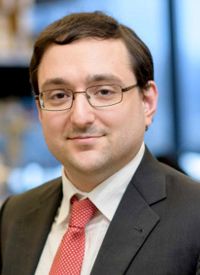Article
Research Abounds in Targeting Rare Mutations in Lung Cancer
Author(s):
Michael D. Offin, MD, discusses ongoing research focusing on some of the less-common targetable mutations in non–small cell lung cancer.
Michael D. Offin, MD

Michael D. Offin, MD
As the use of next-generation sequencing (NGS) in lung cancer increases, ongoing research is focusing on new therapeutics to target less-common mutations that can be identified, explained Michael D. Offin, MD.
“The actionable biomarkers BRAF, RET, MET, and NTRK alterations tend to be some of the rarer alterations in lung cancer,” said Offin, a medical oncologist at Memorial Sloan Kettering Cancer Center. “However, there are approved and emerging data of definite targetable options in that setting.”
In an interview during the 2019 OncLive® State of the Science Summit™ on Non—Small Cell Lung Cancer, Offin discussed ongoing research focusing on some of the less-common targetable mutations in non–small cell lung cancer (NSCLC).
OncLive: What are the current treatment options for patients with NSCLC who harbor MET mutations?
Offin: The current standard of care would be crizotinib (Xalkori), which is in the National Comprehensive Cancer Network (NCCN) guidelines. Capmatinib, tepotinib, and savolitinib are all emerging targetable applications. Each one had a slightly different adverse event profile, [which was reported at the] 2019 ASCO Annual Meeting. The overall response rates (ORRs) were in the 40% to 60% range, depending on which drug we looked at. It's a bit premature to say that one is necessarily better than the other, but we're all very excited to see the data as more patients enroll and they are on these medications longer [to better evaluate] progression-free survival (PFS).
What are some therapeutic updates in the RET landscape?
In the RET space right now, there are NCCN guideline recommendations, but I would say that they are relatively toxic with response rates that are lower than what we would hope for. With selpercatinib, as well as BLU-667, there is hope for a better targetable option here. Both medications are well tolerated. Selpercatinib had a bit of a signal for a slightly better ORR, but it's unfair to say that in a cross-trial comparison. Overall, everyone is very excited and hoping that the breakthrough designation will [quickly] lead to an approval to provide patients with better options.
How has treatment evolved for patients with NTRK fusions?
For NTRK fusions, larotrectinib (Vitrakvi) and entrectinib (Rozlytrek) are in that space now. Larotrectinib was a landmark approval because it was both age and histology agnostic, which is the first time that has occurred. While NTRK fusions are exquisitely rare [and are identified] in less than 1% of all tumors and in about 0.2% of all lung cancers, response rates with [these two agents] are robust and toxicity profiles are reasonable with mostly grade 1/2 adverse events. These medications have changed the way we treat patients with those rare tumors harboring NTRK fusions.
Are there any updates to report in the HER2 setting?
In the HER2 setting, some medications are in the guidelines and others are under further investigation. There is activity with afatinib (Gilotrif) as well as ado-trastuzumab emtansine (T-DM1; Kadcyla). The antibody-drug conjugate (ADC) in the HER2 space showed activity in research that was recently published by Bob T. Li, MD, MPH, and his colleagues. Other medications, including novel ADCs, are under investigation now. The HER2 space is a growing field with many new options [emerging].
What effective strategies are being used to detect biomarkers?
Tissue-based NGS is [a relatively reliable method of] finding targetable mutations. You have to worry about the heterogeneity of the tissue itself, as well as with liquid biopsy or circulating tumor DNA. Many of the mutations are detectable; however, you have to [consider] shedding dynamics. If the patient is on active treatment, there are nuances in the detection rates. The fusions and rearrangements are sometimes more difficult to detect with traditional DNA sequencing.
If a test comes back positive for 1 mutation, what is the likelihood that a patient also harbors another mutation?
In the specific drivers we're discussing, which are RET, MET, NTRK, and BRAF, they are somewhat exclusive. However, I was involved in a project where we looked at MET exon 14 splice site alterations and found concurrent KRAS alterations—both de novo and acquired. There is no hard and fast rule to this. We have to question the paradigm that these [mutations] only happen in a vacuum.
Is there any new research regarding more difficult-to-target mutations, such as EGFR or HER2 exon 20 insertion mutations?
For EGFR, colleagues of mine, such as Gregory J. Riely, MD, PhD, are looking into novel medications. There are ongoing clinical trials evaluating novel tyrosine kinase inhibitors; there are good data on their efficacy that was presented recently. There is some [anecdotal] evidence, as well, for doubling the dose of osimertinib in that setting, which is not approved. The ongoing clinical trials are very exciting, and we all look forward to more data. For the HER2 exon 20 insertion mutation, Li is working in that space to try and figure out what combination strategies could be tested [and found effective] clinical trial settings.
What else should your colleagues know about testing for these mutations in their patients with lung cancer?
There are many clinical trials in these oncogene spaces. Knowing the right genetic platform is very important. When you see a young patient, who is a never-smoker, and their DNA sequencing comes back negative on tissue, you may want to consider supplementing that testing with RNA sequencing or a liquid biopsy. As we begin to understand these rare mutations and find actionable options for them, the sequencing will become more important.









